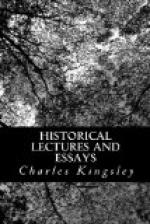Then, in Italy at least, the classic Renaissance gave fresh life to anatomy as to all other sciences. Especially did the improvements in painting and sculpture stir men up to a closer study of the human frame. Leonardo da Vinci wrote a treatise on muscular anatomy. The artist and the sculptor often worked together, and realised that sketch of Michael Angelo’s in which he himself is assisting Fallopius, Vesalius’s famous pupil, to dissect. Vesalius soon found that his thirst for facts could not be slaked by the theories of the Middle Age; so in 1530 he went off to Montpellier, where Francis I. had just founded a medical school, and where the ancient laws of the city allowed the faculty each year the body of a criminal. From thence, after becoming the fellow-pupil and the friend of Rondelet, and probably also of Rabelais and those other luminaries of Montpellier, of whom I spoke in my essay on Rondelet, he returned to Paris to study under old Sylvius, whose real name was Jacques Dubois, alias Jock o’ the Wood; and to learn less—as he complains himself—in an anatomical theatre than a butcher might learn in his shop.
Were it not that the whole question of dissection is one over which it is right to draw a reverent veil, as a thing painful, however necessary and however innocent, it would be easy to raise ghastly laughter in many a reader by the stories which Vesalius himself tells of his struggles to learn anatomy. How old Sylvius tried to demonstrate the human frame from a bit of a dog, fumbling in vain for muscles which he could not find, or which ought to have been there, according to Galen, and were not; while young Vesalius, as soon as the old pedant’s back was turned, took his place, and, to the delight of the students, found for him—provided it were there—what he could not find himself;—how he went body-snatching and gibbet-robbing, often at the danger of his life, as when he and his friend were nearly torn to pieces by the cannibal dogs who haunted the Butte de Montfaucon, or place of public execution;—how he acquired, by a long and dangerous process, the only perfect skeleton then in the world, and the hideous story of the robber to whom it had belonged—all these horrors those who list may read for themselves elsewhere. I hasten past them with this remark—that




